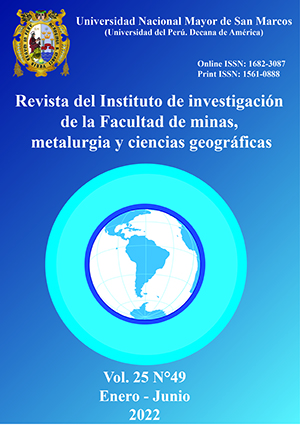Micro plástico: una amenaza imperceptible en la Playa Agua Dulce, distrito de Chorrillos
DOI:
https://doi.org/10.15381/iigeo.v25i49.19219Palabras clave:
micro plásticos, playa Agua Dulce, poliestireno, pelletResumen
El uso de plásticos en el mundo va en aumento, pero su adecuada disposición final es limitada. El Perú realizó esfuerzos normativos para reducir su uso; sin embargo, son actividades aisladas que no han representado un cambio significativo sobre su manejo. Este estudio, permite identificar la presencia de micro plástico en una de las playas más concurridas de la ciudad de Lima Metropolitana, durante el periodo de emergencia provocado por la pandemia de SARS- COV-2. Para lograr los objetivos de la investigación, se ha muestreado en las zonas de alta marea y supra litoral, aplicando la metodología propuesta en la Guía para el muestreo de suelo del Ministerio del Ambiente. En este estudio se evidencia la presencia de micro plástico, con una abundancia de 43 piezas por m2, además se observó que la predominancia del tipo de micro plástico encontrado es de origen secundario (poliestireno y polipropileno); sin embargo, el 20.9% corresponden a micro plástico primario (pellets) cuya fuente no se pudo determinar. Por último, se indica que a pesar de las restricciones por el estado de emergencia la cantidad de micro plásticos por m2 en la Playa Agua Dulce entre los años 2019 (40 piezas) y 2020 (43 piezas) se incrementó en un 7.5%.
Descargas
Publicado
Número
Sección
Licencia
Derechos de autor 2022 Leonela Lourdes Sánchez Contreras, Angie Luz Huamán Quispe, Omar Jair Ángeles Mendiola

Esta obra está bajo una licencia internacional Creative Commons Atribución 4.0.
LOS AUTORES RETIENEN SUS DERECHOS:
a. Los autores retienen sus derechos de marca y patente, y tambien sobre cualquier proceso o procedimiento descrito en el artículo.
b. Los autores retienen el derecho de compartir, copiar, distribuir, ejecutar y comunicar públicamente el articulo publicado en la Rev. Inst. investig. Fac. minas metal cienc. geogr. (por ejemplo, colocarlo en un repositorio institucional o publicarlo en un libro), con un reconocimiento de su publicación inicial en la Rev. Inst. investig. Fac. minas metal cienc. geogr.
c. Los autores retienen el derecho a hacer una posterior publicación de su trabajo, de utilizar el artículo o cualquier parte de aquel (por ejemplo: una compilación de sus trabajos, notas para conferencias, tesis, o para un libro), siempre que indiquen la fuente de publicación (autores del trabajo, revista, volumen, numero y fecha).






